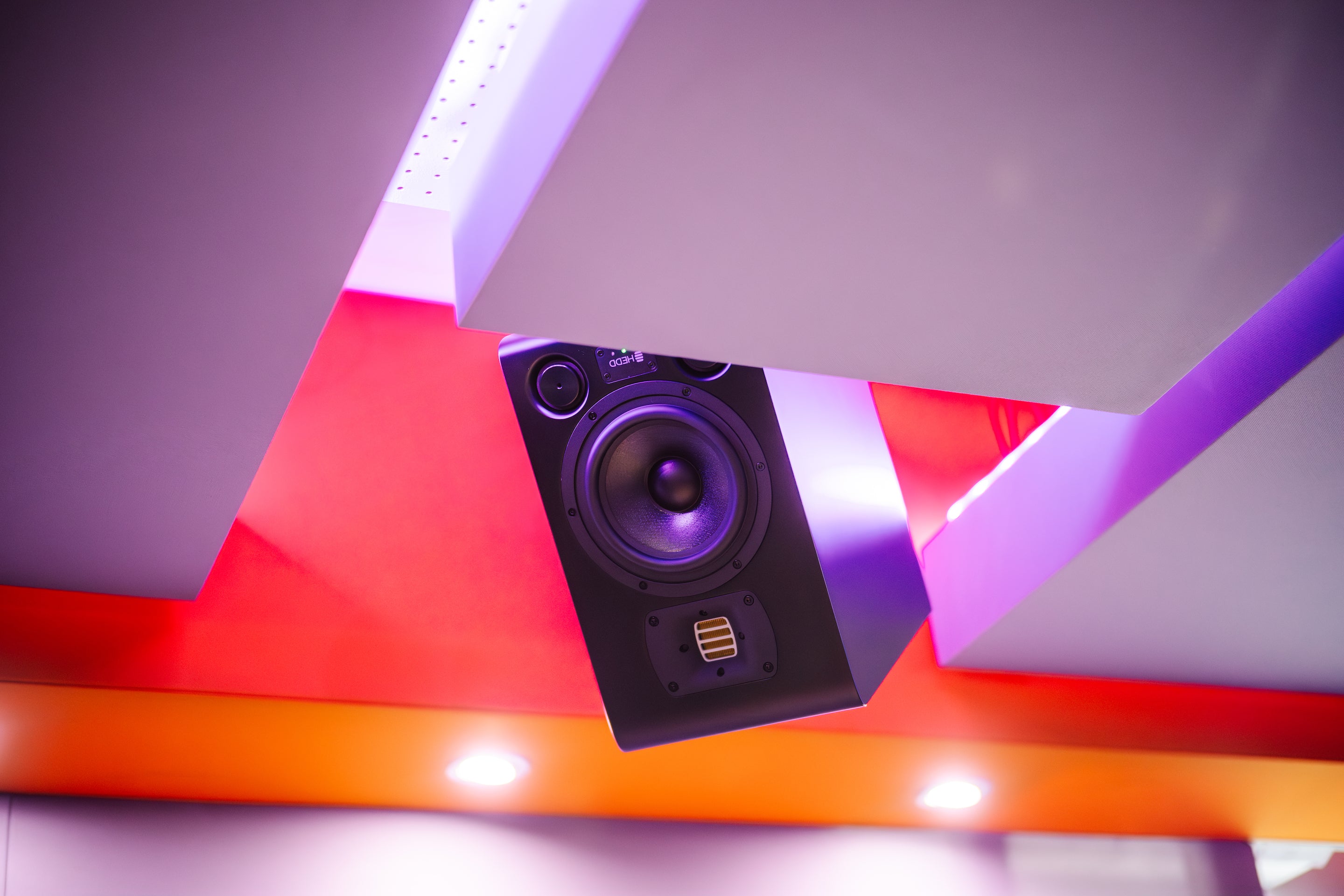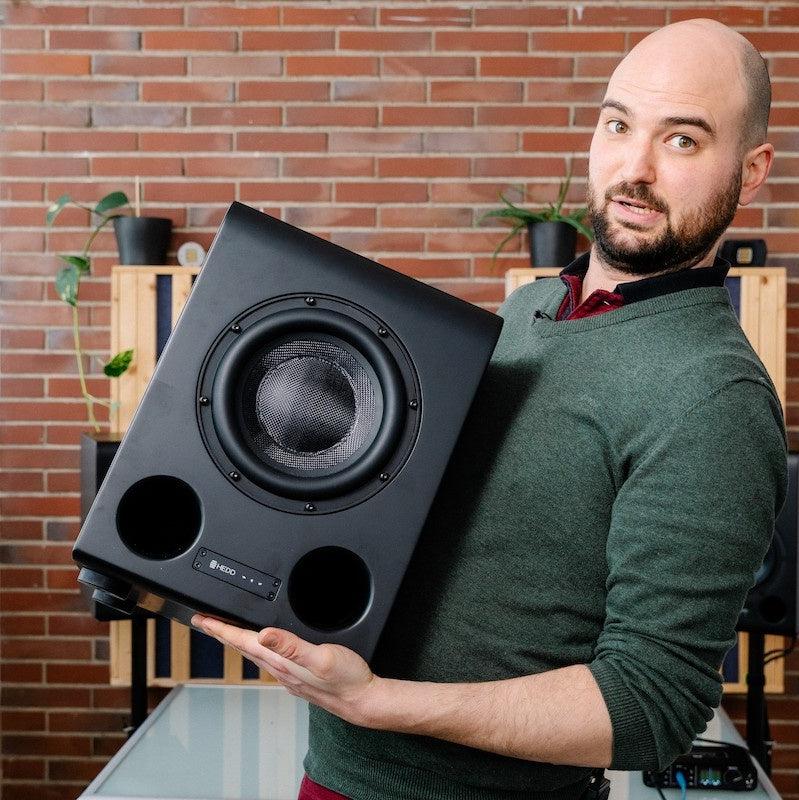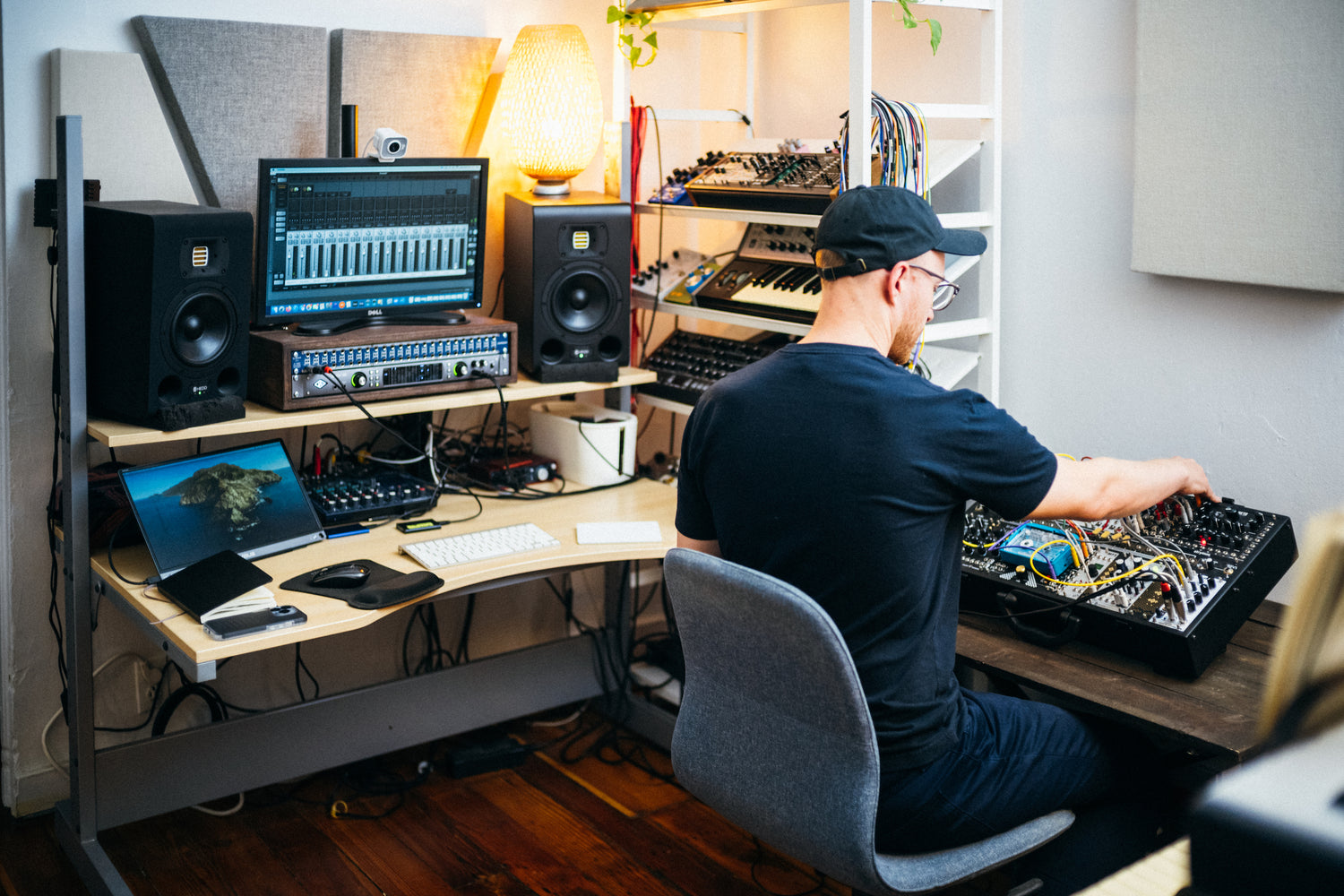
You can spend thousands and thousands on the best outboard gear, speakers, microphones, and plugins, but if your studio environment isn’t optimised you could still easily feel deflated when you listen to your work. Acoustically treating a room is a blend of art and science, an iterative process of trial and error based on the space you have with the goal to stop a room adding its own resonances to what your hear when working, which is especially key when engineering audio whether for a mix or mastering.
Most people don’t need a balanced listening environment at the creative stage (writing, composing, producing). In fact you want the volume and energy and ‘vibe’ that an untreated space often provides for those sessions. But when it comes to critical listening and making small adjustments that combine to create the overall sound of a song then it helps to work in a room that will not be fighting against you.
Achieving a perfectly balanced listening environment is almost impossible for most, due to the cost or space requirements. After all, engineers or audio professionals don't always have the luxury of being able to build rooms from scratch factoring in things like optimal height, width and depth measurements. But there are a great many things that anyone can do to improve their working space in order to get the most out of it and hear the music the way it was intended.
Throughout this guide you'll find tips on approaching acoustic treatment from Jesco Lohan, friend of HEDD and the head of Acoustics Insider .
Speaker Placement
The first thing to do is think about the room that you have and the best place to put your speakers. The common wisdom is to place your speakers so the sound they give out is firing down the longest wall, this means that reflections from the back wall are as far away from your listening position as possible. You would ideally place the speakers equidistant from the side walls and the same distance apart as they are from your head when you're in the listening position. This equilateral triangle forms the basis of all of your following decisions. If you have a deep (front to back) mixing desk that puts you further away from the speakers then they will need to be wider apart. But if you work on a laptop on a small table and are very close to them, then they can be narrower.
The closer your speakers are to a wall or corner, the more bass will be heard in the room. Many speakers have ports to vent out the naturally built up air from inside, this air can cause ‘phantom bass’ that is rarely heard itself but influences and impacts the bass you do hear from the speaker. Given that most listening spaces are small-to-medium in size you will find this to be the main challenge in speaker placement, particularly if you want to use the room for something other than listening. You can dig deeper into where to place your speakers with our studio monitor placement basics .

"Good speaker placement in a home studio actually starts with good listener placement. The idea is to find the room's 'low-end sweet spot' where the standing waves are most balanced, and then place your listening position there. This is key to get a good low end."
Jesco
— Acoustics Insider

Once you’ve found the best/most realistic position for your speakers you can start to add in the other equipment and furniture that you need, paying attention to your workflow and ergonomics so the most used equipment is easiest to reach. You may need to make sure you’ve got enough power outlets near your working area or that there is a convenient way to use extension cords. Then it's time to get comfortable and start listening to some music.
Right: The home studio of Brooklyn-based producer and teacher BlankFor.ms which makes the best use of the space to balance speaker and equipment placement (Credit: Felix Zimmerman).
Referencing
Dial into some of your favourite music, records or songs that you enjoy and know the mixes for well. When you sit in the optimal listening position, aka the sweet spot, of your room do those mixes sound the same as you think they should? Can you hear the sub in the kick drum that you always listen out for? Is the bass powerful or shy? Are the vocals more spikey and aggressive? Is the high-end sparkly enough? Some things may be immediately apparent, others may take time for you to pick up on but these are the first indicators of what impact your room is having on the music.
You may also want to play some test tones, sine sweeps or white/pink noise to help identify the frequency bands that are being problematic. There are lots of digital room correction solutions available that can give you a visual guide to the dips/peaks in your room too - see our Immersive Audio guide for more.

"Acoustic measurements won't tell you how to treat your home studio. The problem is way too complex unless you're a professional. It's much more efficient and effective to treat your room based on principles and then, perhaps, double check with measurements to see if you missed anything."
Jesco
— Acoustics Insider
Speaker Check
The first place to look at when addressing the sound of the room is your speakers. It’s a lot easier to make adjustments within the monitors than to start filling your room with absorbers and diffusers.
Most professional monitors today, and especially those which include Digital Signal Processors , will have options to change or control their frequency response including filtering the bass to cut out unnecessary sub frequencies or high-shelf filters that give you more ‘air’.
The HEDD MK2 range of monitors also give you the ability to flatten the speaker phase in order to time align the signals within the monitor, thanks to the DSP-powered Lineariser tool , which will help stop some of the phase issues you may find in your room before they even start.
Let’s Decorate
There are many different items of what is often known as ‘studio furniture’ that can be used to address the various problematic frequencies in your room. While ready-made products exist, if you’re handy with basic power tools you can also design and build your own absorbers and diffusers. Doing it yourself has the benefit of allowing you to create solutions to address very specific frequency issues you might be facing by digging into the maths.
Below: The home studio of Grégory Betton, located in his garage in Paris, features a range of panels to help optimise the acoustics of the space for immersive audio work.
Bass traps
As the name suggests, bass traps are boxes filled with absorptive material that are built to specific dimensions in order to affect specific frequency ranges. Rock wool, fiber glass, and even shredded denim can be used to ‘catch’ frequencies and in doing so convert the sound energy into heat. This helps to reduce/eliminate the energy that rebounds back into the room and prevents bass nodes, which can significantly boost or reduce certain frequencies. As the ‘old’ sound wave that is reflected off a wall hits the ‘new’ sound wave coming from the speakers it causes a level of phase cancellation/boosting depending on where in the cycle they hit. This means the frequency is heard louder or quieter than normal and impacts how you balance sound whilst mixing or mastering.
Typically installed behind or beneath speakers and in corners or at the back of the room, bass traps can greatly improve the bass accuracy of a room but can come at the cost of space. Bass traps can become large and bulky - the bigger the trap, the lower the frequency they ‘catch’ - so there is often a balance to be found between treating the room and not making it feel cramped. A good option is putting a sofa at the back of the room as their size and density can make them useful for soaking up bass.

"You can improve just about any room to the point where mixes translate reliably. Don't chase perfection, it doesn't exist. Focus on the things you can do (listener/speaker placement, reflection control, overall bass trapping) instead of obsessing about that one thing you can't fix, like that one corner where you can't put a bass trap."
Jesco
— Acoustics Insider
Mid-Range panels
With the bass being absorbed by the traps we now look at the mid-range. Issues with mid-range will often present in audible reflections, mainly from the side walls in front of the speakers, and can lead to vocals and electric guitars sounding harsh and difficult to place in the mix properly.
The goal with the mid-range panels is to stop frequencies bouncing back and forth repeatedly, stopping the build up before they start. Treating the mid-range is easier than the bass as absorbers can be hung at the pinch-points along the walls relatively easily and you can start off by finding the first-reflection point. We know that speakers don’t fire sound at you in a straight line, it’s more of a relatively broad band which helps us hear a stereo image, but also means that there is often sound that will reach our ears after hitting a wall first. These early reflections can blur the stereo field and make level balancing a more volatile process, so they can have a huge impact on how you engage with the music.
You’ll want to move the panels around and test their effectiveness whilst you play a reference track/sine sweeps - either ask a friend to hold them whilst you sit in the sweet spot or prop them up on a chair. Keep them at ear/speaker height first and add more panels as you peel back the layers of the reflection onion that is your room. Once you’ve addressed the ear-level reflections you can identify any frequencies bouncing directly between the ceiling and the floor - sometimes a good carpet or rug can fix this but you may want to hang mid-range panels from the ceiling. Some monitors (like the HEDD MK2 range) provide a desk-filter to reduce the amount of sound they fire down at your mixing desk/workstation but it may be useful to hang panels and create a ‘cloud’ above your speakers/sweet spot too.
Diffusers
The bass traps and mid-range panels are designed to stop reflections affecting your listening by absorbing the sound waves that hit them, thus reducing the amount of sound energy in the room. Diffusers also stop standing waves but in the opposite way - by bouncing frequencies around the room at ‘random’ angles so they don’t bounce back on themselves. Diffusers can take many different shapes and sizes providing they scatter the sound waves that hit them - a bookshelf (stocked with plenty of differently sized books) on your back wall will do the same job as a purpose-built diffuser, but with less repeatable results. Studios likeDecoy in the UK andBlackbird in Nashville have created innovative, bespoke diffusers that are visually impactful as well as serving a sonic purpose.

"Don't chase a 'flat' acoustic frequency response. It does not exist. The closest you will ever get is in a fully treated but completely empty room, apart from the speakers and the microphone. As soon as you put any furniture in the room you'll start seeing reflections and issues with frequency response."
Jesco
— Acoustics Insider
Conclusion
There are so many ways to impact the sound of your room. Pre-made traps, panels, and diffusers now come in a variety of shapes, sizes, and colours, so treating your room doesn’t have to mean being surrounded by empty egg boxes any more. You can also experiment with non-traditional alternatives like hanging rugs on your walls instead of panels or installing thick curtains to cover your windows - every change will make a difference in one way or another.
Just remember to ask yourself if the changes are going to absorb (sofas, thick rugs, etc) or scatter (bookshelves, record boxes, big plants, etc) the sounds that hit them. Good luck on your journey of iterative changes!
We'll leave the last word to our acoustics insider, Jesco Lohan: "You don't need a fully treated studio to get your mixes to translate. Mix translation is a skill that you learn over time. Acoustic treatment is a force multiplier, but it won't do any of the work for you. Some people do great with just basic treatment, others prefer to have as much control over their studio sound as possible. What you need exactly is something only you can figure out. That's why it's so important to get started asap, gain experience, and adjust as you go along."
